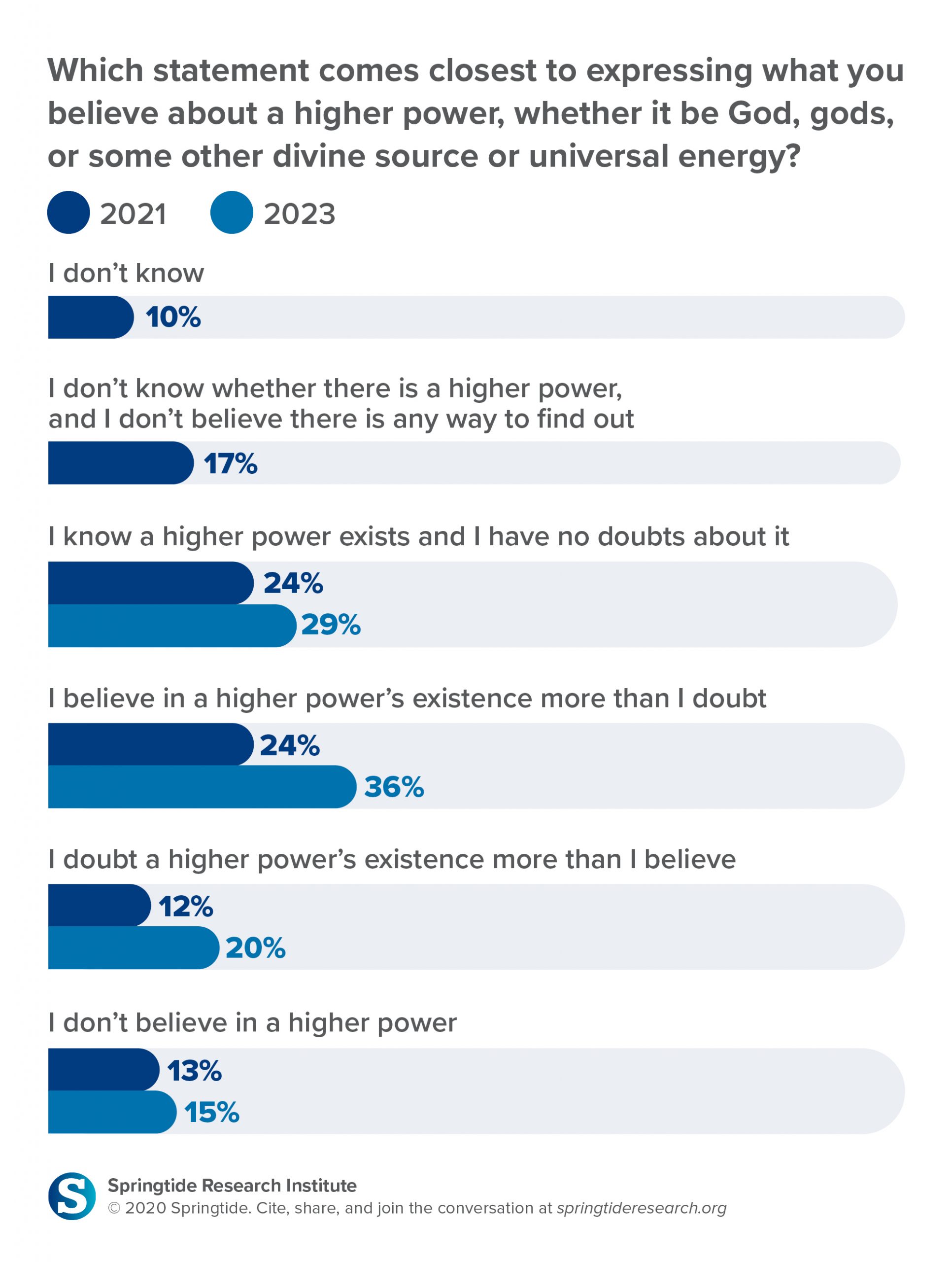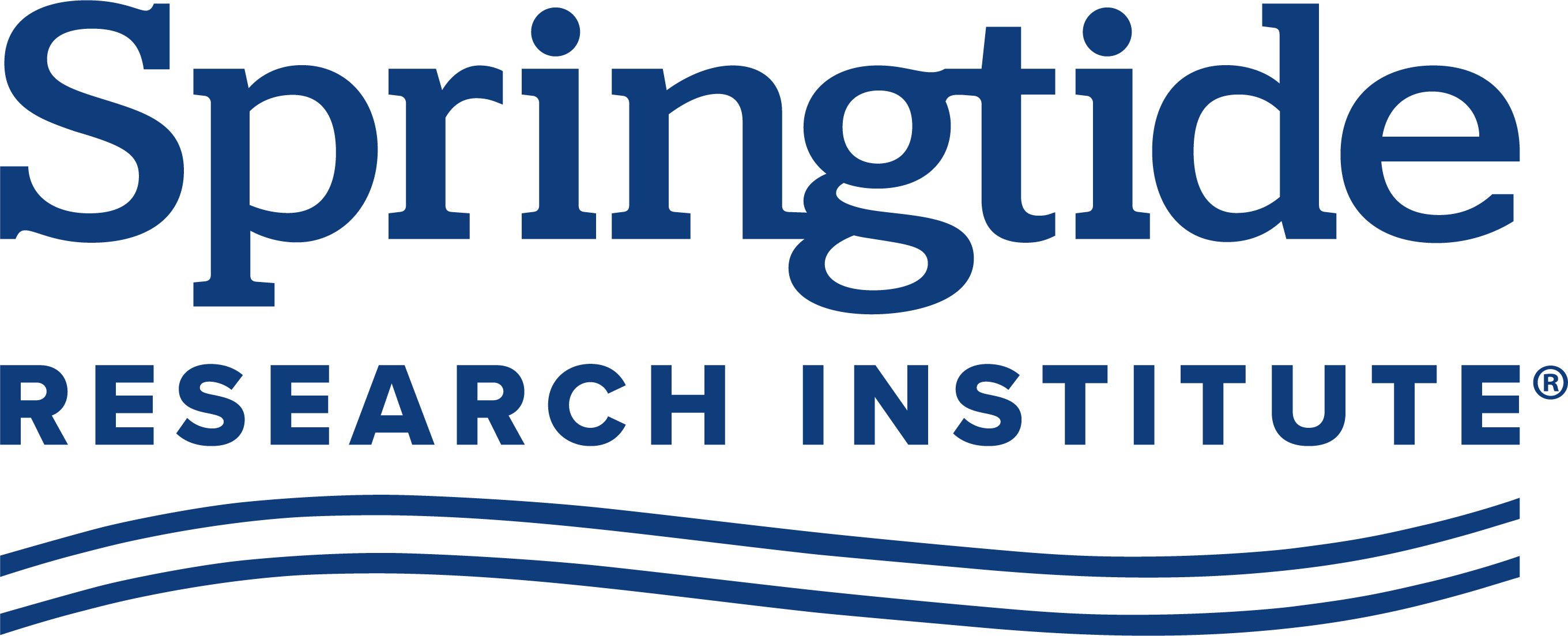Gen Z and Belief: A Closer Look
One of Springtide’s key aims is to illustrate how young people understand and make meaning in an increasingly complex world. One way we do this is by exploring how young people use religion and spirituality in the meaning making process. We survey thousands of young people annually about their faith identities, practices, and beliefs. To get an accurate snapshot of young people’s religious and spiritual lives, we ask questions that capture religious expressions both within traditional religious institutions and beyond them.
This is important because what we have found over the years is that young people who identify as “religious” increasingly construct their faith in nontraditional terms. It also means that traditional metrics used in the past to measure religiosity (things like religious service attendance or prayer) are no longer the only reliable measures of religiosity.
One of the many metrics we use to measure religiosity is belief in a higher power. In the past three years, we’ve asked young people about how much they believe in the existence of a higher power versus how much they doubt it. One data point that has drawn recent interest is that about one-third (35%) of 18 to 25-year-olds today say they believe in a higher power’s existence more than they doubt.
But do these data signal a shift among young people towards greater belief in God or an increase in religiosity? Not necessarily. Here are three important points to keep in mind when interpreting these data.
Definitions of a Higher Power
We use the term “higher power” as opposed to “God” to account for the diversity of young people who take our surveys. This includes young people from various religions, but also other worldviews like secular humanism, atheism, and agnosticism. So, while young people may believe in the existence of a higher power, they may simultaneously reject that this higher power is anything like the God, gods, or divine source embraced by any given faith tradition.
Take Maggie, 19, for example, with whom we spoke to in 2022 for our annual report, “The State of Religion and Young People.” Maggie grew up in the LDS Church but has since disaffiliated. When we asked her if she had a belief in a higher power, she told us:
It’s definitely something that I’m trying to figure out because I don’t know if I believe in God or Jesus Christ. But if there’s one thing I know, it’s that there’s a heavenly mother. It’s not a white guy in the sky. I know that in heaven, there’s a mother, not a father.
—Maggie, 19
Maggie clearly believes in a higher power. But like others in her generational cohort, it is not the higher power Maggie heard about growing up.
Response Options
In our surveys, young people’s opinions about whether they believe in a higher power more than they doubt is not asked as a standalone question. Rather, it’s part of a scale of response options to a broader question about belief. The question we ask of young people — “Which statement comes closest to expressing what you believe about a higher power, whether it be God, gods, or some other divine source or universal energy?” — has not changed over the years, but the response options to the question have. Four of the response options have remained consistent: “I don’t believe in the existence of a higher power,” “I doubt a higher power’s existence more than I believe,” “I believe in a higher power’s existence more than I doubt,” and “I know a higher power exists and I have no doubts about it”.
However, in 2021, there were two additional response options: “I don’t know whether there is a higher power, and I don’t believe there’s a way to find out” and “I don’t know.” We omitted these neutral response options starting in 2023 to eliminate redundancy and invite respondents to consider each option more deeply. There are pros and cons to this approach. While some research suggests that questions without neutral response options can introduce undesirable measurement errors, other studies suggest that excluding a neutral response option can improve reliability.

Source: Springtide Research Institute survey of young people ages 13-25 for “The State of Religion and Young People” 2021 (N=10,274) and 2023 (N=4,544). Percentages are rounded up to the nearest whole number.
Comparing Results
What does this mean for interpreting the results? Well, when comparing between 2021 and 2023, the changes in the response options means that our comparison is not direct. This is because in 2021, young people had the option to remain neutral. But in 2023, young people who would have chosen a neutral option had to instead choose something else.
There is also a question of where the 2023 increase in the response option, “I believe in a higher power’s existence more than I doubt” comes from. Since this response option is in the middle of the scale, the increase in this option must come from a decrease in one or more other response options. In other words, the increase in this response option may be coming from a decrease in one of the options that signal disbelief or doubt in a higher power. But the increase could also be coming from a decrease in absolute certainty in the existence of a higher power.
These considerations mean that assessing young people’s belief in a higher power is not as straightforward as it might seem. And the bigger question — are young people becoming more religious? — cannot be answered by a single data point or metric. Additional research is needed to identify what young people mean when they say they are religious, or when they say they believe in a higher power. For example, what do young people say are the characteristics of this higher power? How do these characteristics differ from institutional or traditional beliefs about a higher power, if at all? What does it mean to identify as “religious” in a context with rising unaffiliation?
You can start by asking these questions now to the young people you serve. It’s a great opportunity to listen and connect with the young people in your life on their terms. Young people may not always share your tradition’s vocabulary, but their spiritual yearning and curiosity are there.
On our end, we’ll keep tracking responses to this question over time. Seeing how responses to our question about belief ebb and flow across a longer timespan will help us better answer whether belief in a higher power is increasing, decreasing, or remaining steady.






